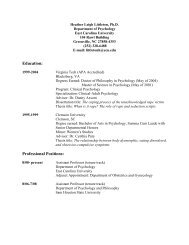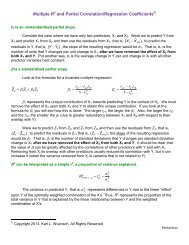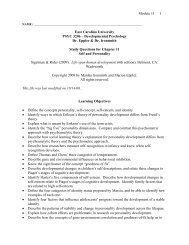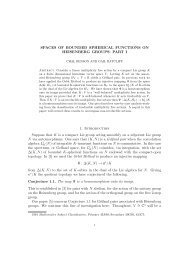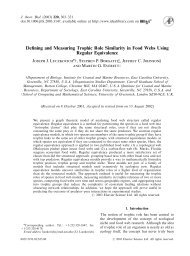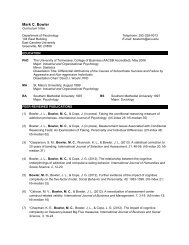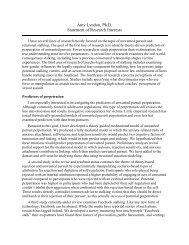Modeling Information for Three-Dimensional Space - Ecu
Modeling Information for Three-Dimensional Space - Ecu
Modeling Information for Three-Dimensional Space - Ecu
You also want an ePaper? Increase the reach of your titles
YUMPU automatically turns print PDFs into web optimized ePapers that Google loves.
Carliner<br />
APPLIED RESEARCH<br />
Lessons Learned from Museum Exhibit Design<br />
back to the professional communities of instructional and<br />
in<strong>for</strong>mation designers, I undertook a qualitative study of<br />
the design <strong>for</strong> three permanent exhibitions in history and<br />
technology museums, and related background and follow-up<br />
research.<br />
The primary purpose of the study was to understand<br />
how members of the design team addressed instructional<br />
issues as they designed exhibits and to see which design<br />
practices <strong>for</strong> <strong>for</strong>mal learning transferred to the design <strong>for</strong><br />
in<strong>for</strong>mal learning in museum exhibits. The exhibits were<br />
purposely selected and included exhibits on<br />
The history of a major city in the U.S. at an urban<br />
history museum<br />
The history of the canning industry in the late 19 th<br />
century at an industrial history museum in the U.S.<br />
Computer and telecommunications networks at a<br />
high technology museum in the U.S.<br />
In the main study, each member of the “core” design<br />
team was interviewed three times. Core team members are<br />
those who play a primary role in designing and developing<br />
the exhibit. These team members include<br />
An idea generator who devises the concept <strong>for</strong> the<br />
exhibit, chooses the content, and writes the “storyline”<br />
(a detailed description of the exhibit and the<br />
preliminary draft of copy <strong>for</strong> the labels that appear<br />
in the exhibit)<br />
The exhibit designer, who prepares the physical design<br />
of the exhibit, including its floor plan and<br />
graphic identity; chooses wall and floor coverings;<br />
designs display cases; and prepares blue prints<br />
An idea implementer who acts as a general contractor<br />
of sorts <strong>for</strong> the exhibit, securing objects <strong>for</strong> the<br />
exhibit that are not in the museum collection, overseeing<br />
the work of the peripheral team (specialists<br />
who implement the plans), ensuring conservation of<br />
items to be displayed, and making sure that the design<br />
is implemented according to plans<br />
For each exhibit, members of the peripheral team were<br />
also interviewed when feasible. These team members provide<br />
specialized skills needed to develop a part of the<br />
exhibition. Skills needed on the peripheral team vary<br />
among exhibits. Typically, this team includes a museum<br />
ducator (whose job is to develop programs geared toward<br />
school groups that are related to the exhibit content),<br />
public programs coordinator (whose job is to develop<br />
programs geared toward adults and the general public),<br />
registrar (whose job is to oversee the documentation and<br />
protection of objects in exhibits), media specialists (including<br />
video and interactive specialists), and editor (whose job<br />
is to edit the copy <strong>for</strong> all labels and gallery guides associated<br />
with an exhibition). In addition to the interviews, I<br />
observed team meetings and reviewed project plans when<br />
feasible.<br />
The study followed the groundedtheory<br />
methodology.<br />
The study followed the grounded-theory methodology.<br />
A central feature of this methodology is constant<br />
comparative analysis. That is, data is constantly analyzed<br />
throughout the data collection process to devise theories;<br />
collected data is later compared with the evolving theory to<br />
determine whether it supports the theory (Strauss and<br />
Corbin 1994, p. 273). Strauss and Corbin suggest a threephase<br />
process <strong>for</strong> analyzing data. The first phase is open<br />
coding, which they define as “the process of breaking<br />
down, examining, comparing, conceptualizing, and categorizing<br />
data.” The next phase is axial coding, “a set of<br />
procedures whereby data [is] put back together in new<br />
ways after open coding, by making connections between<br />
categories” (Strauss and Corbin 1990, p. 96). The last phase<br />
is selective coding, “the process of selecting the core category,<br />
systematically relating it to other categories, validating<br />
those relationships, and filling in categories that need<br />
further refinement and development” (1990, p. 116).<br />
Whenever they are coding, researchers mainly look <strong>for</strong><br />
dominant patterns—patterns that appear in all sites studied.<br />
Researchers also look <strong>for</strong> weak patterns: ones that<br />
occur in at least two sites. Researchers try to explain why a<br />
weak pattern might not be observed at the other sites.<br />
Besides the core research <strong>for</strong> this study, I conducted<br />
preliminary and follow-up research. This research consisted<br />
of a literature review; observations of visitor behavior<br />
in a science center in a large city in the U.S.; visits to<br />
over 200 museums in the U.S., Canada, Europe, and Asia;<br />
and participation in two conferences and other events <strong>for</strong><br />
museum exhibit designers.<br />
1. “DID ANYONE TARGET AN AGE GROUP”<br />
What I observed in museums<br />
Because visits to museums are voluntary in nature, museum<br />
staffs must motivate people to visit (Csikzentmihalyi<br />
and Hermanson 1995). First, museum staffs must motivate<br />
visitors to enter the building. To do that, they must work<br />
past an impression among the public that museums are<br />
primarily intended <strong>for</strong> people from upper economic classes<br />
and the majority religious and racial groups (Zolberg 1994).<br />
Such impressions have, in the past, made people from<br />
outside of those groups feel unwelcome in museums. This<br />
challenge is similar to that faced by businesses that want to<br />
sell products and services outside of their countries or to<br />
historically marginalized groups like women, African<br />
Americans, Latinos, and gays and lesbians.<br />
To address this concern, museums have attempted to<br />
broaden their constituencies. This is a policy of the mu-<br />
Volume 48, Number 1, February 2001 • TechnicalCOMMUNICATION 67



